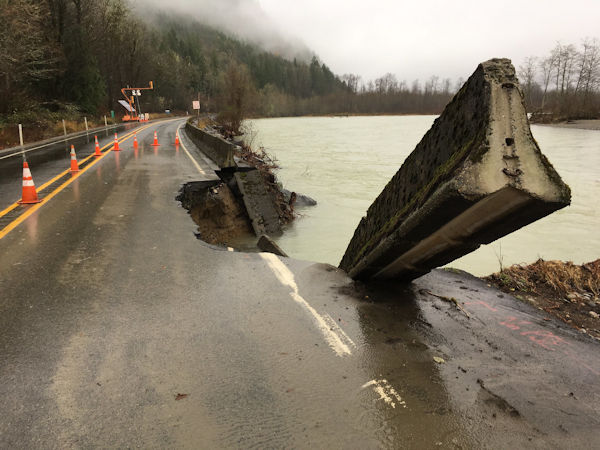SEJournal Online is the digital news magazine of the Society of Environmental Journalists. Learn more about SEJournal Online, including submission, subscription and advertising information.
 |
| A state road along Washington's Skagit River damaged by floods in November 2017. Much of a trillion-dollar infrastructure bill will be spent by states, with funding coming through from the federal Department of Transportation. Photo: Washington State Department of Transportation, Flickr Creative Commons (CC BY-NC-ND 2.0). |
Reporter’s Toolbox: Unpacking Bipartisan Infrastructure Law With Data … But Not Databases
By Joseph A. Davis
Literally thousands of projects are going to be funded under the $1 trillion “bipartisan infrastructure bill.” So there ought to be a database for that, right?
Sadly, there isn’t. Perhaps it is too complex and diffuse. Perhaps nobody is obsessive enough (yet). Perhaps somebody is already working on it. Perhaps somebody should be.
Hoping to help, Toolbox is going to offer some resources herein. There will be a lot of data, although in forms that don’t fit well into databases.
One reason there ought to be more data is that it could help state and local governments find money to fund their worthwhile projects.
One reason for better data is that
when Uncle Sugar is doling out
that many billions, there will
inevitably be “misspending.”
Another reason for better data is that when Uncle Sugar is doling out that many billions, there will inevitably be “misspending.” It is the job of journalists to watch for waste, fraud and abuse.
Another key thing to realize is that the money trickles down through levels of government: federal to state to local. That means that it changes form at each stage.
The other thing to understand is that the money comes out over years until January 2026. Project spending in one year isn’t necessarily predictable from other years.
If you are trying to track this money, much of your work will be at the state level — and every state is different, which makes it hard to offer general advice. The Transportation Department, which spends a large share of the money, has a state breakdown.
Where the data comes from and how to use it smartly
Let’s start with essentials.
First is the summary and full text of the bill, also known as the Infrastructure Investment and Jobs Act. It is very large and very hard to translate, but it is the horse’s mouth. Much shorter is a fact sheet released by the White House that can be useful as a starting point or overview.
A more comprehensive overview is the White House’s 465-page “Guidebook to the Bipartisan Infrastructure Law for State, Local, Tribal, and Territorial Governments, and Other Partners.”
Because the funding for various types of projects goes through the various appropriate federal agencies first, you may want to be looking at the summaries and overviews from the agencies.
Here’s a list of helpful links:
- U.S. Environmental Protection Agency: Fact sheets and an overview.
- Department of Transportation: This dashboard links you to the many sub-agencies.
- Department of Energy: This page links to fact sheets, FAQs and a list of funding opportunities.
- Interior Department: Visit an overview page and an implementation blueprint.
- Water agencies: Check the Army Corps of Engineers (an overview release, an investment infographic and a policy primer) and the Bureau of Reclamation (investments and spending plan).
Other resources you may find helpful include this breakdown from the National Association of Counties. Also worthwhile may be this overview from Pew Trusts, and this big-picture look from the National Conference of State Legislatures.
Joseph A. Davis is a freelance writer/editor in Washington, D.C. who has been writing about the environment since 1976. He writes SEJournal Online's TipSheet, Reporter's Toolbox and Issue Backgrounder, and curates SEJ's weekday news headlines service EJToday and @EJTodayNews. Davis also directs SEJ's Freedom of Information Project and writes the WatchDog opinion column.
* From the weekly news magazine SEJournal Online, Vol. 7, No. 24. Content from each new issue of SEJournal Online is available to the public via the SEJournal Online main page. Subscribe to the e-newsletter here. And see past issues of the SEJournal archived here.













 Advertisement
Advertisement 



